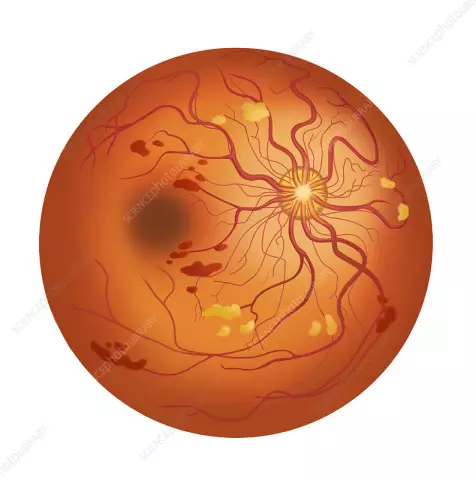- Author Rachel Wainwright [email protected].
- Public 2023-12-15 07:39.
- Last modified 2025-11-02 20:14.
Retinal disinsertion
The retina is the thin inner lining of the eyeball, which is located between the vitreous humor and the choroid and is responsible for the perception of visual information. In the retina itself, there are no sensitive nerve endings, so retinal diseases are painless.
Normally, the mesh and choroid of the eye are tightly adjacent to each other. Retinal detachment is a pathological condition in which there is a separation of the retinal and vascular membranes. If a patient with a retinal detachment is not urgently provided with qualified medical care, it threatens with irreversible loss of vision.

Causes and types of retinal detachment
Most often, retinal detachment is observed in high myopia, but it also occurs in other pathologies. Predisposing factors can be trauma and penetrating wounds of the eyes, inflammatory diseases, diabetic retinopathy, hypertension, hematomas and neoplasms of the eyes, gross structural changes in the vitreous body (moorings), hyperextension of the eyeball and ischemia, etc.
Retinal detachment can be primary or secondary. If the retinal detachment is preceded by its rupture, accompanied by fluid leakage under it, this pathology is called primary retinal detachment. With secondary retinal detachment, breaks may be absent.
Depending on the cause of the retinal detachment, there are:
- traumatic retinal detachment, which occurs as a result of an eye injury;
- rhegmatogenous (from rhegma - rupture) retinal detachment resulting from rupture of the retina;
- traction retinal detachment associated with retinal tension in patients with changes in the vitreous body;
- exudative retinal detachment resulting from neoplasms or inflammatory eye diseases.
Symptoms
Retinal detachment is an absolutely painless process. Detachment can be suspected when there is a sudden deterioration in vision, accompanied by the appearance of "shroud", floating points, "lightning" or "sparks" in front of the eyes, especially if these symptoms occur after falling or lifting weights. Deformation of the outlines of objects when looking at them, limitation of lateral vision can also indicate the beginning of retinal detachment.
Diagnostics
If you experience the above symptoms, you need to see a doctor urgently. Delay in making a diagnosis can result in irreversible loss of vision. If a retinal detachment is suspected, a comprehensive visual examination is performed, including:
- determination of visual acuity;
- ophthalmoscopy (fundus examination);
- perimetry (examination of visual fields);
- ultrasound scanning;
- biomicroscopy.
Retinal Detachment Treatment
Retinal detachment can only be treated surgically and requires immediate intervention. The goal of treatment is to limit the tear zone and prevent further progression of retinal detachment. Extrascleral interventions are used (filling and ballooning of the sclera in the retinal tear zone) and endovitreal interventions (vitrectomy with aspiration of subretinal fluid and subsequent tamponade of the rupture site).
Also, with retinal detachment, laser methods of treatment are also used (preventive and restrictive laser coagulation of the retina).
Found a mistake in the text? Select it and press Ctrl + Enter.




